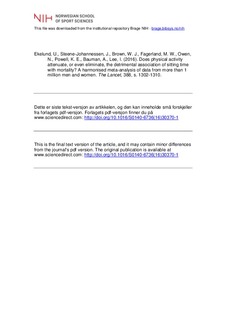| dc.contributor.author | Ekelund, Ulf | |
| dc.contributor.author | Steene-Johannessen, Jostein | |
| dc.contributor.author | Brown, Wendy J. | |
| dc.contributor.author | Fagerland, Morten Wang | |
| dc.contributor.author | Owen, Neville | |
| dc.contributor.author | Powell, Kenneth E. | |
| dc.contributor.author | Bauman, Adrian | |
| dc.contributor.author | Lee, I-Min | |
| dc.date.accessioned | 2017-04-20T07:23:05Z | |
| dc.date.available | 2017-04-20T07:23:05Z | |
| dc.date.issued | 2016-09 | |
| dc.identifier.citation | The Lancet. 2016, 388, 1302-1310 | nb_NO |
| dc.identifier.uri | http://hdl.handle.net/11250/2440010 | |
| dc.description | I Brage finner du siste tekst-versjon av artikkelen, og den kan inneholde ubetydelige forskjeller fra forlagets pdf-versjon. Forlagets pdf-versjon finner du på www.sciencedirect.com / In Brage you'll find the final text version of the article, and it may contain insignificant differences from the journal's pdf version. The definitive version is available at www.sciencedirect.com | nb_NO |
| dc.description.abstract | Background: High amounts of sedentary behaviour have been associated with increased risks of several chronic conditions and mortality. However, it is unclear whether physical activity attenuates or even eliminates the detrimental effects of prolonged sitting. We examined the associations of sedentary behaviour and physical activity with all-cause mortality. Methods: We did a systematic review, searching six databases (PubMed, PsycINFO, Embase, Web of Science, Sport Discus, and Scopus) from database inception until October, 2015, for prospective cohort studies that had individual level exposure and outcome data, provided data on both daily sitting or TV-viewing time and physical activity, and reported effect estimates for all-cause mortality, cardiovascular disease mortality, or breast, colon, and colorectal cancer mortality. We included data from 16 studies, of which 14 were identified through a systematic review and two were additional unpublished studies where pertinent data were available. All study data were analysed according to a harmonised protocol, which categorised reported daily sitting time and TV-viewing time into four standardised groups each, and physical activity into quartiles (in metabolic equivalent of task [MET]-hours per week). We then combined data across all studies to analyse the association of daily sitting time and physical activity with all-cause mortality, and estimated summary hazard ratios using Cox regression. We repeated these analyses using TV-viewing time instead of daily sitting time. | nb_NO |
| dc.language.iso | eng | nb_NO |
| dc.publisher | Elsevier | nb_NO |
| dc.subject | cardiovascular diseases | |
| dc.subject | *exercise | |
| dc.subject | female | |
| dc.subject | humans | |
| dc.subject | male | |
| dc.subject | mortality | |
| dc.subject | proportional hazards models | |
| dc.subject | prospective studies | |
| dc.subject | risk factors | |
| dc.subject | *sedentary lifestyle | |
| dc.subject | television | |
| dc.subject | time factors | |
| dc.title | Does physical activity attenuate, or even eliminate, the detrimental association of sitting time with mortality? A harmonised meta-analysis of data from more than 1 million men and women | nb_NO |
| dc.type | Journal article | nb_NO |
| dc.type | Peer reviewed | nb_NO |
| dc.subject.nsi | VDP::Medisinske Fag: 700::Basale medisinske, odontologiske og veterinærmedisinske fag: 710 | nb_NO |
| dc.subject.nsi | VDP::Medisinske Fag: 700::Klinisk medisinske fag: 750 | nb_NO |
| dc.subject.nsi | VDP::Medisinske Fag: 700::Helsefag: 800 | nb_NO |
| dc.source.journal | The Lancet | nb_NO |
| dc.identifier.doi | 10.1016/S0140-6736(16)30370-1 | |
| dc.description.localcode | Seksjon for idrettsmedisinske fag / Department of Sports Medicine | nb_NO |
